Research Project: Technology's Role in Ryanair Customer Satisfaction
VerifiedAdded on 2020/02/05
|29
|4817
|66
Report
AI Summary
This research project investigates the role of technology in enhancing customer satisfaction within Ryanair Airlines. The report begins by outlining the aims and objectives, which include assessing technology's impact, measuring customer service effectiveness, identifying technical traits, and recommending improvements. It then reviews relevant literature, discussing resource implications and contributory factors like personal interest and technological advancements. The methodology section details the interpretivism research philosophy, inductive approach, data collection methods (primary and secondary), qualitative data analysis, and random sampling of UKCBC students. The findings are presented, including demographics, educational background, and frequency of Ryanair usage, along with a Gantt chart outlining the project timeline. The report aims to provide a comprehensive analysis of customer satisfaction within the airline industry, specifically focusing on Ryanair, and offers valuable insights into how technology can improve customer service and overall experience.
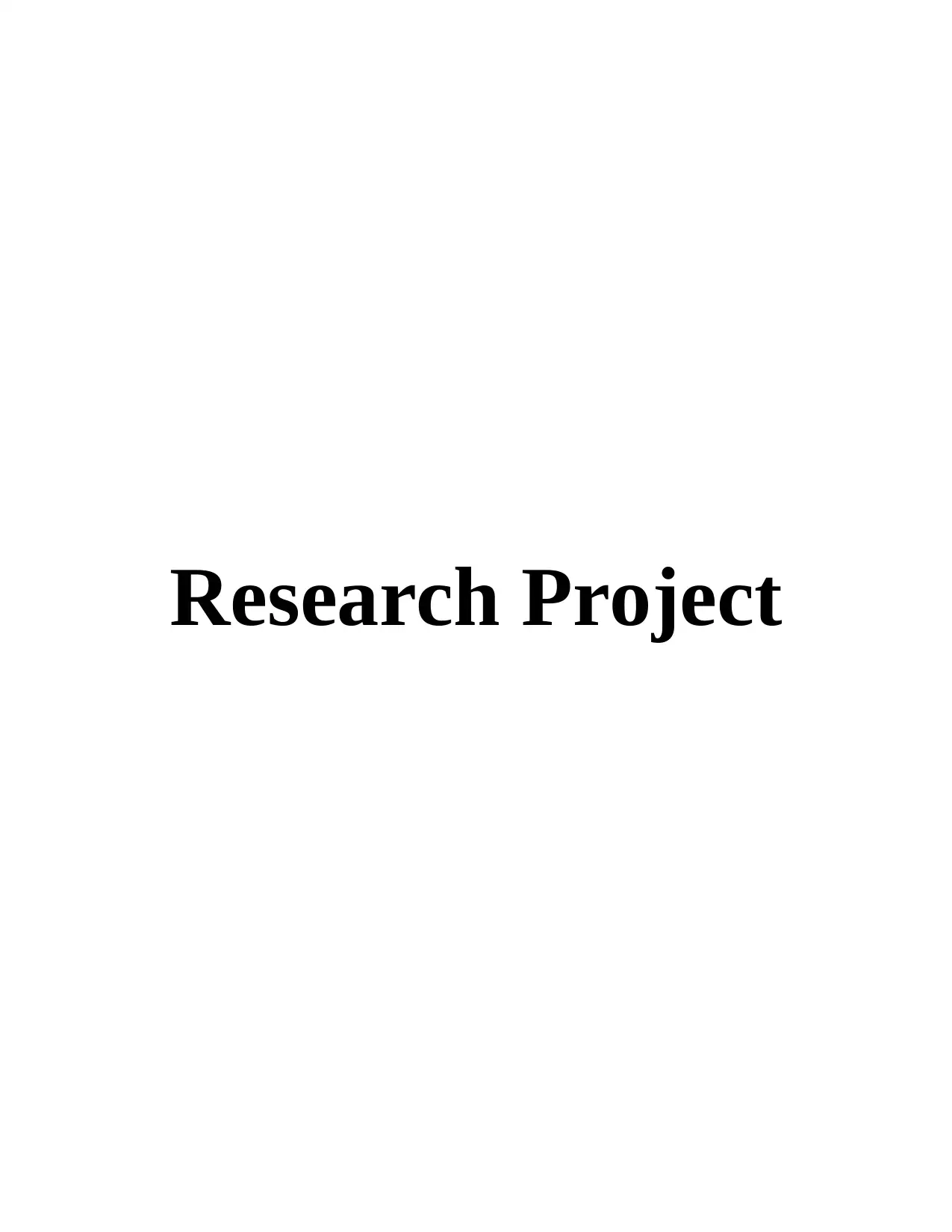
Research Project
Paraphrase This Document
Need a fresh take? Get an instant paraphrase of this document with our AI Paraphraser
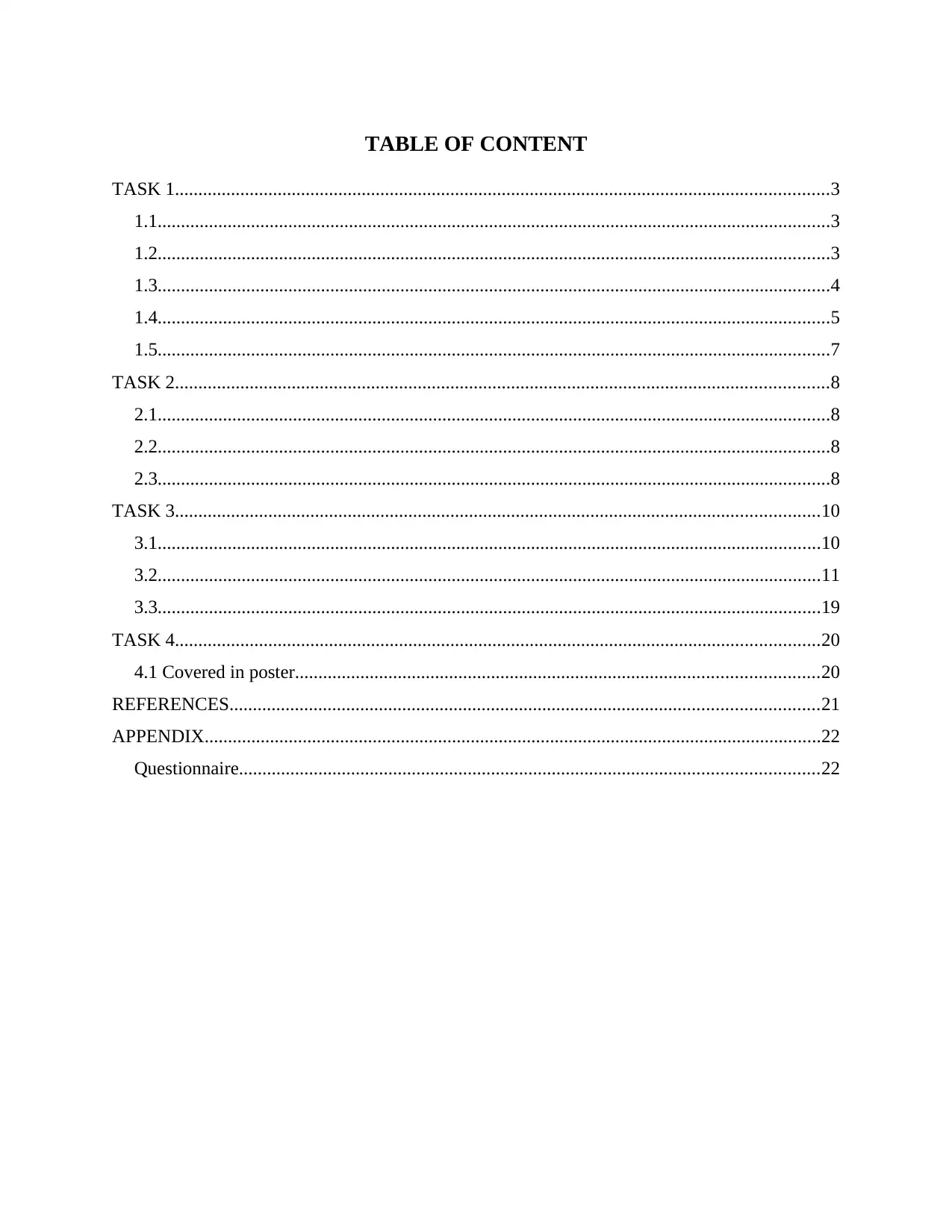
TABLE OF CONTENT
TASK 1............................................................................................................................................3
1.1................................................................................................................................................3
1.2................................................................................................................................................3
1.3................................................................................................................................................4
1.4................................................................................................................................................5
1.5................................................................................................................................................7
TASK 2............................................................................................................................................8
2.1................................................................................................................................................8
2.2................................................................................................................................................8
2.3................................................................................................................................................8
TASK 3..........................................................................................................................................10
3.1..............................................................................................................................................10
3.2..............................................................................................................................................11
3.3..............................................................................................................................................19
TASK 4..........................................................................................................................................20
4.1 Covered in poster................................................................................................................20
REFERENCES..............................................................................................................................21
APPENDIX....................................................................................................................................22
Questionnaire............................................................................................................................22
TASK 1............................................................................................................................................3
1.1................................................................................................................................................3
1.2................................................................................................................................................3
1.3................................................................................................................................................4
1.4................................................................................................................................................5
1.5................................................................................................................................................7
TASK 2............................................................................................................................................8
2.1................................................................................................................................................8
2.2................................................................................................................................................8
2.3................................................................................................................................................8
TASK 3..........................................................................................................................................10
3.1..............................................................................................................................................10
3.2..............................................................................................................................................11
3.3..............................................................................................................................................19
TASK 4..........................................................................................................................................20
4.1 Covered in poster................................................................................................................20
REFERENCES..............................................................................................................................21
APPENDIX....................................................................................................................................22
Questionnaire............................................................................................................................22
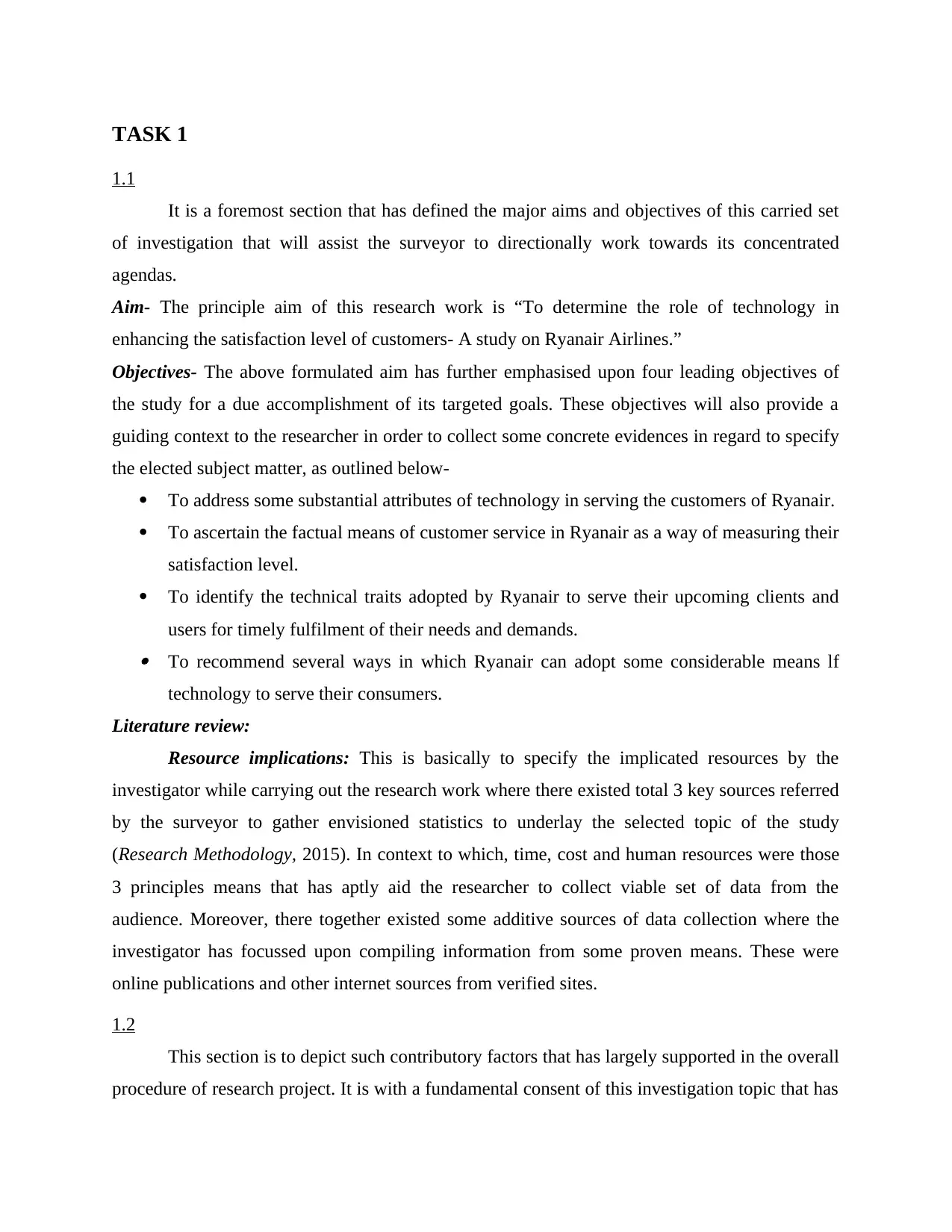
TASK 1
1.1
It is a foremost section that has defined the major aims and objectives of this carried set
of investigation that will assist the surveyor to directionally work towards its concentrated
agendas.
Aim- The principle aim of this research work is “To determine the role of technology in
enhancing the satisfaction level of customers- A study on Ryanair Airlines.”
Objectives- The above formulated aim has further emphasised upon four leading objectives of
the study for a due accomplishment of its targeted goals. These objectives will also provide a
guiding context to the researcher in order to collect some concrete evidences in regard to specify
the elected subject matter, as outlined below-
To address some substantial attributes of technology in serving the customers of Ryanair.
To ascertain the factual means of customer service in Ryanair as a way of measuring their
satisfaction level.
To identify the technical traits adopted by Ryanair to serve their upcoming clients and
users for timely fulfilment of their needs and demands. To recommend several ways in which Ryanair can adopt some considerable means lf
technology to serve their consumers.
Literature review:
Resource implications: This is basically to specify the implicated resources by the
investigator while carrying out the research work where there existed total 3 key sources referred
by the surveyor to gather envisioned statistics to underlay the selected topic of the study
(Research Methodology, 2015). In context to which, time, cost and human resources were those
3 principles means that has aptly aid the researcher to collect viable set of data from the
audience. Moreover, there together existed some additive sources of data collection where the
investigator has focussed upon compiling information from some proven means. These were
online publications and other internet sources from verified sites.
1.2
This section is to depict such contributory factors that has largely supported in the overall
procedure of research project. It is with a fundamental consent of this investigation topic that has
1.1
It is a foremost section that has defined the major aims and objectives of this carried set
of investigation that will assist the surveyor to directionally work towards its concentrated
agendas.
Aim- The principle aim of this research work is “To determine the role of technology in
enhancing the satisfaction level of customers- A study on Ryanair Airlines.”
Objectives- The above formulated aim has further emphasised upon four leading objectives of
the study for a due accomplishment of its targeted goals. These objectives will also provide a
guiding context to the researcher in order to collect some concrete evidences in regard to specify
the elected subject matter, as outlined below-
To address some substantial attributes of technology in serving the customers of Ryanair.
To ascertain the factual means of customer service in Ryanair as a way of measuring their
satisfaction level.
To identify the technical traits adopted by Ryanair to serve their upcoming clients and
users for timely fulfilment of their needs and demands. To recommend several ways in which Ryanair can adopt some considerable means lf
technology to serve their consumers.
Literature review:
Resource implications: This is basically to specify the implicated resources by the
investigator while carrying out the research work where there existed total 3 key sources referred
by the surveyor to gather envisioned statistics to underlay the selected topic of the study
(Research Methodology, 2015). In context to which, time, cost and human resources were those
3 principles means that has aptly aid the researcher to collect viable set of data from the
audience. Moreover, there together existed some additive sources of data collection where the
investigator has focussed upon compiling information from some proven means. These were
online publications and other internet sources from verified sites.
1.2
This section is to depict such contributory factors that has largely supported in the overall
procedure of research project. It is with a fundamental consent of this investigation topic that has
⊘ This is a preview!⊘
Do you want full access?
Subscribe today to unlock all pages.

Trusted by 1+ million students worldwide
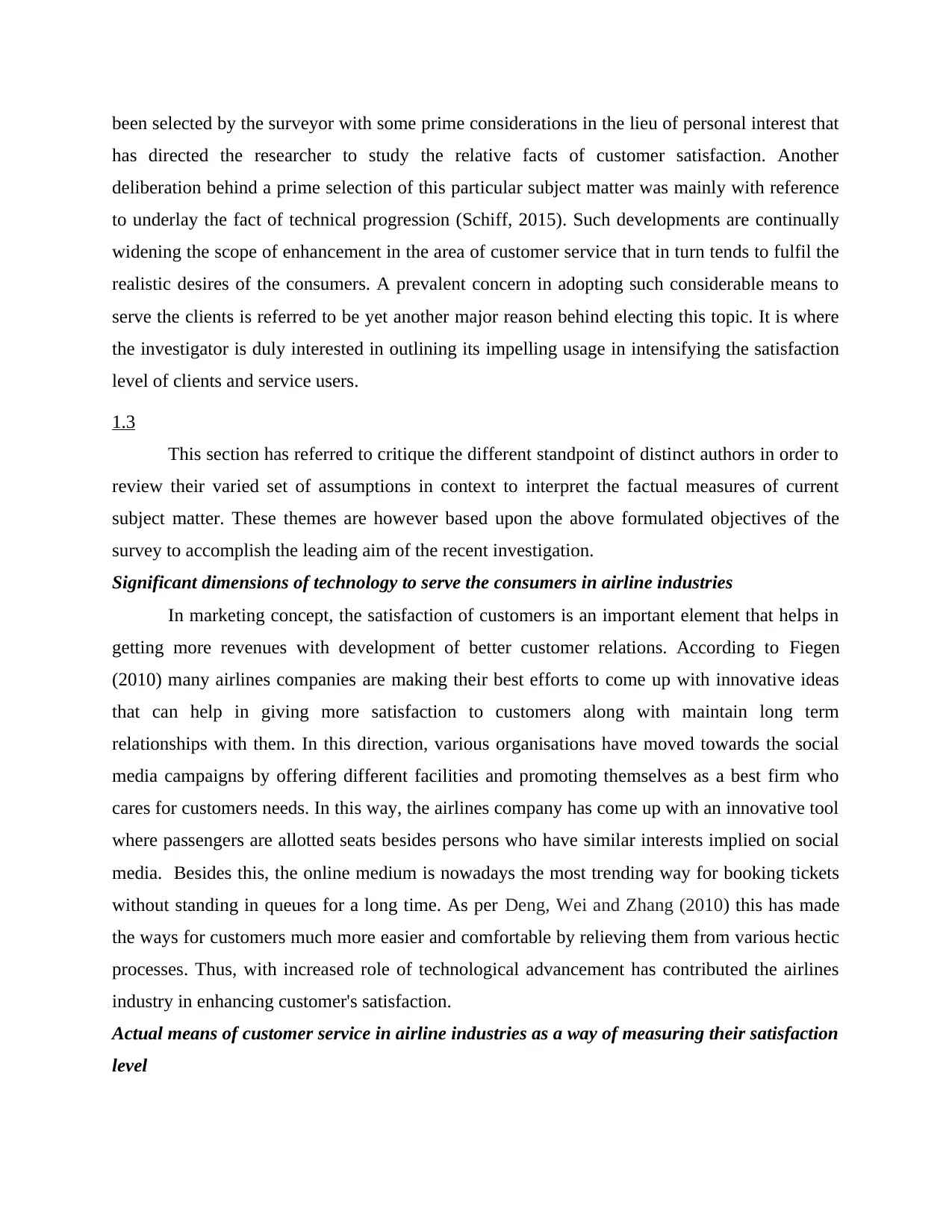
been selected by the surveyor with some prime considerations in the lieu of personal interest that
has directed the researcher to study the relative facts of customer satisfaction. Another
deliberation behind a prime selection of this particular subject matter was mainly with reference
to underlay the fact of technical progression (Schiff, 2015). Such developments are continually
widening the scope of enhancement in the area of customer service that in turn tends to fulfil the
realistic desires of the consumers. A prevalent concern in adopting such considerable means to
serve the clients is referred to be yet another major reason behind electing this topic. It is where
the investigator is duly interested in outlining its impelling usage in intensifying the satisfaction
level of clients and service users.
1.3
This section has referred to critique the different standpoint of distinct authors in order to
review their varied set of assumptions in context to interpret the factual measures of current
subject matter. These themes are however based upon the above formulated objectives of the
survey to accomplish the leading aim of the recent investigation.
Significant dimensions of technology to serve the consumers in airline industries
In marketing concept, the satisfaction of customers is an important element that helps in
getting more revenues with development of better customer relations. According to Fiegen
(2010) many airlines companies are making their best efforts to come up with innovative ideas
that can help in giving more satisfaction to customers along with maintain long term
relationships with them. In this direction, various organisations have moved towards the social
media campaigns by offering different facilities and promoting themselves as a best firm who
cares for customers needs. In this way, the airlines company has come up with an innovative tool
where passengers are allotted seats besides persons who have similar interests implied on social
media. Besides this, the online medium is nowadays the most trending way for booking tickets
without standing in queues for a long time. As per Deng, Wei and Zhang (2010) this has made
the ways for customers much more easier and comfortable by relieving them from various hectic
processes. Thus, with increased role of technological advancement has contributed the airlines
industry in enhancing customer's satisfaction.
Actual means of customer service in airline industries as a way of measuring their satisfaction
level
has directed the researcher to study the relative facts of customer satisfaction. Another
deliberation behind a prime selection of this particular subject matter was mainly with reference
to underlay the fact of technical progression (Schiff, 2015). Such developments are continually
widening the scope of enhancement in the area of customer service that in turn tends to fulfil the
realistic desires of the consumers. A prevalent concern in adopting such considerable means to
serve the clients is referred to be yet another major reason behind electing this topic. It is where
the investigator is duly interested in outlining its impelling usage in intensifying the satisfaction
level of clients and service users.
1.3
This section has referred to critique the different standpoint of distinct authors in order to
review their varied set of assumptions in context to interpret the factual measures of current
subject matter. These themes are however based upon the above formulated objectives of the
survey to accomplish the leading aim of the recent investigation.
Significant dimensions of technology to serve the consumers in airline industries
In marketing concept, the satisfaction of customers is an important element that helps in
getting more revenues with development of better customer relations. According to Fiegen
(2010) many airlines companies are making their best efforts to come up with innovative ideas
that can help in giving more satisfaction to customers along with maintain long term
relationships with them. In this direction, various organisations have moved towards the social
media campaigns by offering different facilities and promoting themselves as a best firm who
cares for customers needs. In this way, the airlines company has come up with an innovative tool
where passengers are allotted seats besides persons who have similar interests implied on social
media. Besides this, the online medium is nowadays the most trending way for booking tickets
without standing in queues for a long time. As per Deng, Wei and Zhang (2010) this has made
the ways for customers much more easier and comfortable by relieving them from various hectic
processes. Thus, with increased role of technological advancement has contributed the airlines
industry in enhancing customer's satisfaction.
Actual means of customer service in airline industries as a way of measuring their satisfaction
level
Paraphrase This Document
Need a fresh take? Get an instant paraphrase of this document with our AI Paraphraser
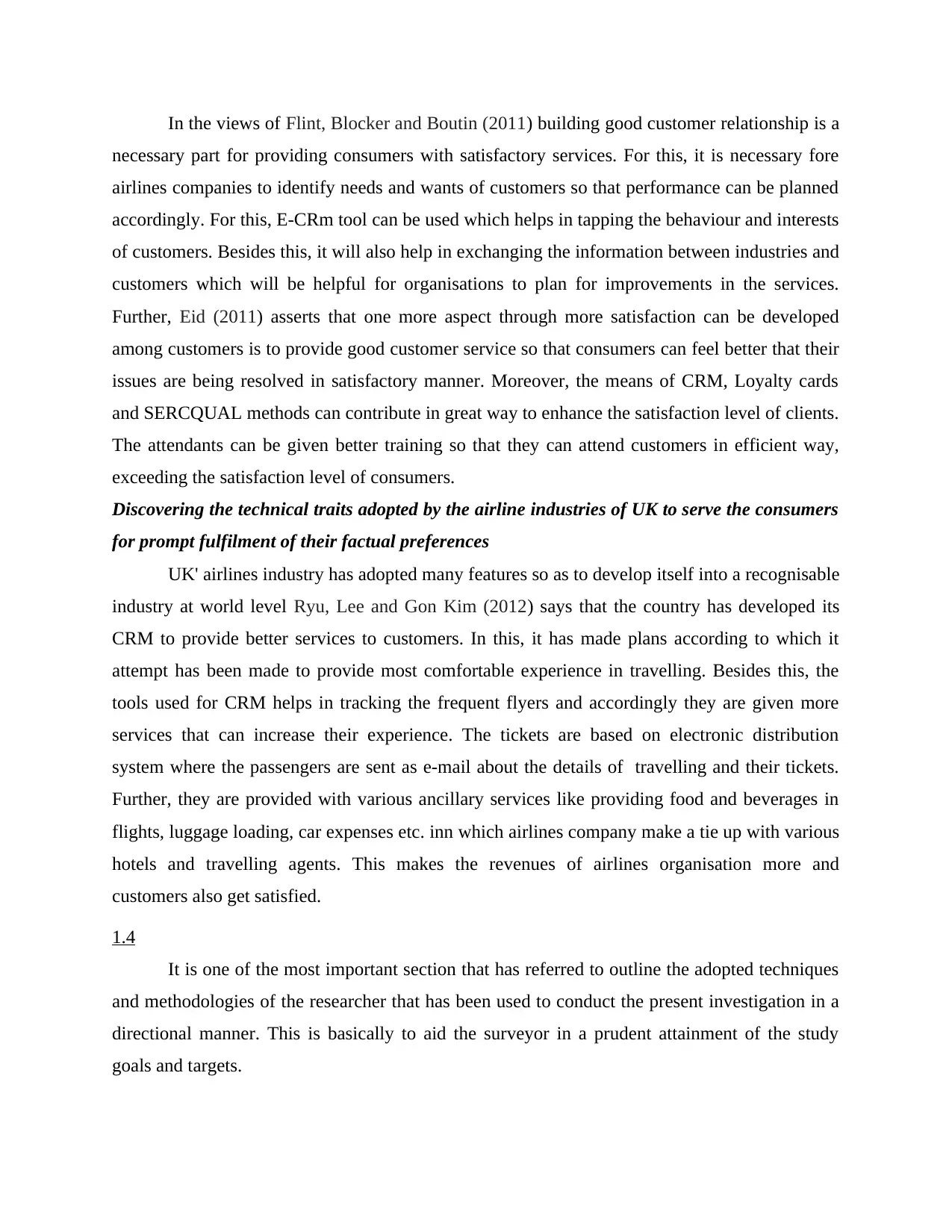
In the views of Flint, Blocker and Boutin (2011) building good customer relationship is a
necessary part for providing consumers with satisfactory services. For this, it is necessary fore
airlines companies to identify needs and wants of customers so that performance can be planned
accordingly. For this, E-CRm tool can be used which helps in tapping the behaviour and interests
of customers. Besides this, it will also help in exchanging the information between industries and
customers which will be helpful for organisations to plan for improvements in the services.
Further, Eid (2011) asserts that one more aspect through more satisfaction can be developed
among customers is to provide good customer service so that consumers can feel better that their
issues are being resolved in satisfactory manner. Moreover, the means of CRM, Loyalty cards
and SERCQUAL methods can contribute in great way to enhance the satisfaction level of clients.
The attendants can be given better training so that they can attend customers in efficient way,
exceeding the satisfaction level of consumers.
Discovering the technical traits adopted by the airline industries of UK to serve the consumers
for prompt fulfilment of their factual preferences
UK' airlines industry has adopted many features so as to develop itself into a recognisable
industry at world level Ryu, Lee and Gon Kim (2012) says that the country has developed its
CRM to provide better services to customers. In this, it has made plans according to which it
attempt has been made to provide most comfortable experience in travelling. Besides this, the
tools used for CRM helps in tracking the frequent flyers and accordingly they are given more
services that can increase their experience. The tickets are based on electronic distribution
system where the passengers are sent as e-mail about the details of travelling and their tickets.
Further, they are provided with various ancillary services like providing food and beverages in
flights, luggage loading, car expenses etc. inn which airlines company make a tie up with various
hotels and travelling agents. This makes the revenues of airlines organisation more and
customers also get satisfied.
1.4
It is one of the most important section that has referred to outline the adopted techniques
and methodologies of the researcher that has been used to conduct the present investigation in a
directional manner. This is basically to aid the surveyor in a prudent attainment of the study
goals and targets.
necessary part for providing consumers with satisfactory services. For this, it is necessary fore
airlines companies to identify needs and wants of customers so that performance can be planned
accordingly. For this, E-CRm tool can be used which helps in tapping the behaviour and interests
of customers. Besides this, it will also help in exchanging the information between industries and
customers which will be helpful for organisations to plan for improvements in the services.
Further, Eid (2011) asserts that one more aspect through more satisfaction can be developed
among customers is to provide good customer service so that consumers can feel better that their
issues are being resolved in satisfactory manner. Moreover, the means of CRM, Loyalty cards
and SERCQUAL methods can contribute in great way to enhance the satisfaction level of clients.
The attendants can be given better training so that they can attend customers in efficient way,
exceeding the satisfaction level of consumers.
Discovering the technical traits adopted by the airline industries of UK to serve the consumers
for prompt fulfilment of their factual preferences
UK' airlines industry has adopted many features so as to develop itself into a recognisable
industry at world level Ryu, Lee and Gon Kim (2012) says that the country has developed its
CRM to provide better services to customers. In this, it has made plans according to which it
attempt has been made to provide most comfortable experience in travelling. Besides this, the
tools used for CRM helps in tracking the frequent flyers and accordingly they are given more
services that can increase their experience. The tickets are based on electronic distribution
system where the passengers are sent as e-mail about the details of travelling and their tickets.
Further, they are provided with various ancillary services like providing food and beverages in
flights, luggage loading, car expenses etc. inn which airlines company make a tie up with various
hotels and travelling agents. This makes the revenues of airlines organisation more and
customers also get satisfied.
1.4
It is one of the most important section that has referred to outline the adopted techniques
and methodologies of the researcher that has been used to conduct the present investigation in a
directional manner. This is basically to aid the surveyor in a prudent attainment of the study
goals and targets.
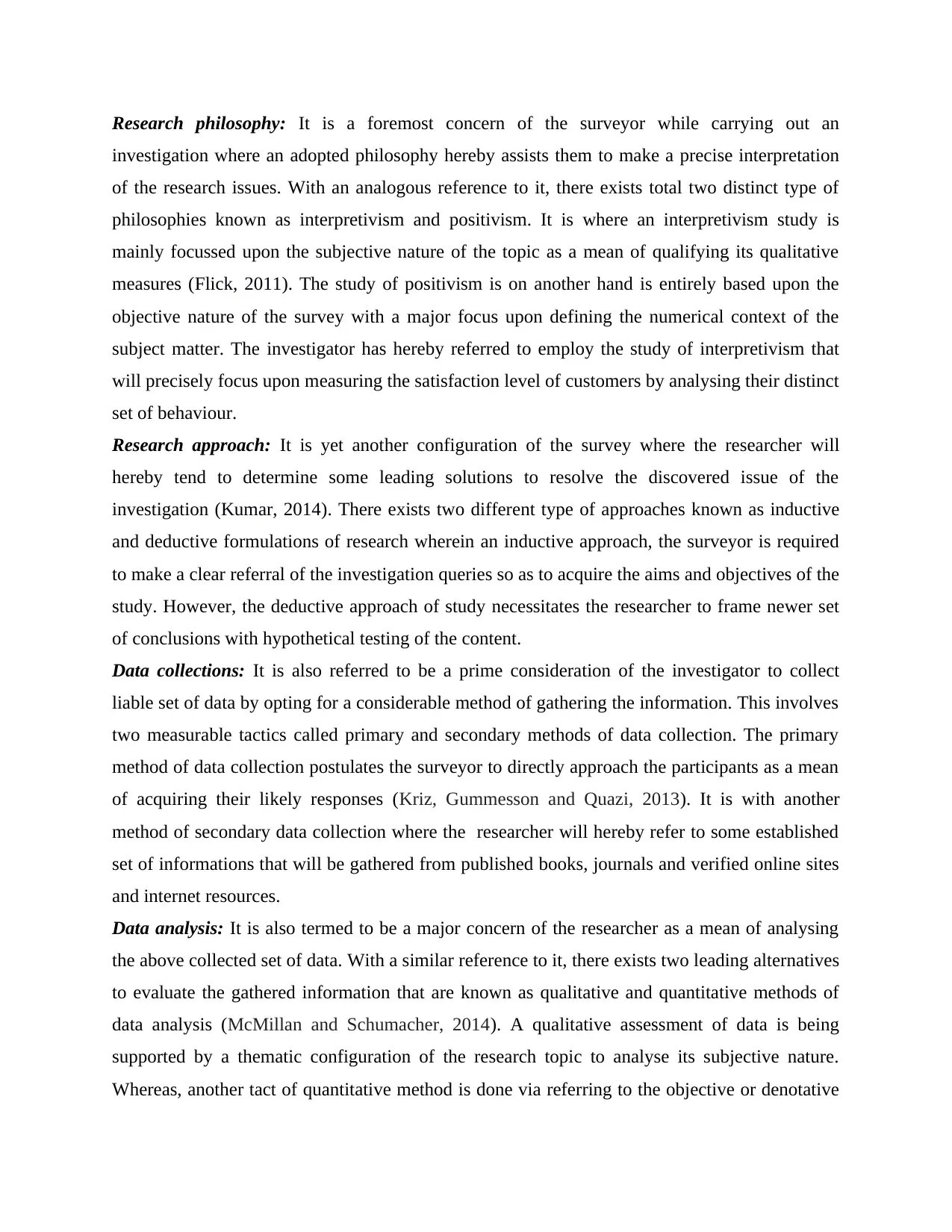
Research philosophy: It is a foremost concern of the surveyor while carrying out an
investigation where an adopted philosophy hereby assists them to make a precise interpretation
of the research issues. With an analogous reference to it, there exists total two distinct type of
philosophies known as interpretivism and positivism. It is where an interpretivism study is
mainly focussed upon the subjective nature of the topic as a mean of qualifying its qualitative
measures (Flick, 2011). The study of positivism is on another hand is entirely based upon the
objective nature of the survey with a major focus upon defining the numerical context of the
subject matter. The investigator has hereby referred to employ the study of interpretivism that
will precisely focus upon measuring the satisfaction level of customers by analysing their distinct
set of behaviour.
Research approach: It is yet another configuration of the survey where the researcher will
hereby tend to determine some leading solutions to resolve the discovered issue of the
investigation (Kumar, 2014). There exists two different type of approaches known as inductive
and deductive formulations of research wherein an inductive approach, the surveyor is required
to make a clear referral of the investigation queries so as to acquire the aims and objectives of the
study. However, the deductive approach of study necessitates the researcher to frame newer set
of conclusions with hypothetical testing of the content.
Data collections: It is also referred to be a prime consideration of the investigator to collect
liable set of data by opting for a considerable method of gathering the information. This involves
two measurable tactics called primary and secondary methods of data collection. The primary
method of data collection postulates the surveyor to directly approach the participants as a mean
of acquiring their likely responses (Kriz, Gummesson and Quazi, 2013). It is with another
method of secondary data collection where the researcher will hereby refer to some established
set of informations that will be gathered from published books, journals and verified online sites
and internet resources.
Data analysis: It is also termed to be a major concern of the researcher as a mean of analysing
the above collected set of data. With a similar reference to it, there exists two leading alternatives
to evaluate the gathered information that are known as qualitative and quantitative methods of
data analysis (McMillan and Schumacher, 2014). A qualitative assessment of data is being
supported by a thematic configuration of the research topic to analyse its subjective nature.
Whereas, another tact of quantitative method is done via referring to the objective or denotative
investigation where an adopted philosophy hereby assists them to make a precise interpretation
of the research issues. With an analogous reference to it, there exists total two distinct type of
philosophies known as interpretivism and positivism. It is where an interpretivism study is
mainly focussed upon the subjective nature of the topic as a mean of qualifying its qualitative
measures (Flick, 2011). The study of positivism is on another hand is entirely based upon the
objective nature of the survey with a major focus upon defining the numerical context of the
subject matter. The investigator has hereby referred to employ the study of interpretivism that
will precisely focus upon measuring the satisfaction level of customers by analysing their distinct
set of behaviour.
Research approach: It is yet another configuration of the survey where the researcher will
hereby tend to determine some leading solutions to resolve the discovered issue of the
investigation (Kumar, 2014). There exists two different type of approaches known as inductive
and deductive formulations of research wherein an inductive approach, the surveyor is required
to make a clear referral of the investigation queries so as to acquire the aims and objectives of the
study. However, the deductive approach of study necessitates the researcher to frame newer set
of conclusions with hypothetical testing of the content.
Data collections: It is also referred to be a prime consideration of the investigator to collect
liable set of data by opting for a considerable method of gathering the information. This involves
two measurable tactics called primary and secondary methods of data collection. The primary
method of data collection postulates the surveyor to directly approach the participants as a mean
of acquiring their likely responses (Kriz, Gummesson and Quazi, 2013). It is with another
method of secondary data collection where the researcher will hereby refer to some established
set of informations that will be gathered from published books, journals and verified online sites
and internet resources.
Data analysis: It is also termed to be a major concern of the researcher as a mean of analysing
the above collected set of data. With a similar reference to it, there exists two leading alternatives
to evaluate the gathered information that are known as qualitative and quantitative methods of
data analysis (McMillan and Schumacher, 2014). A qualitative assessment of data is being
supported by a thematic configuration of the research topic to analyse its subjective nature.
Whereas, another tact of quantitative method is done via referring to the objective or denotative
⊘ This is a preview!⊘
Do you want full access?
Subscribe today to unlock all pages.

Trusted by 1+ million students worldwide
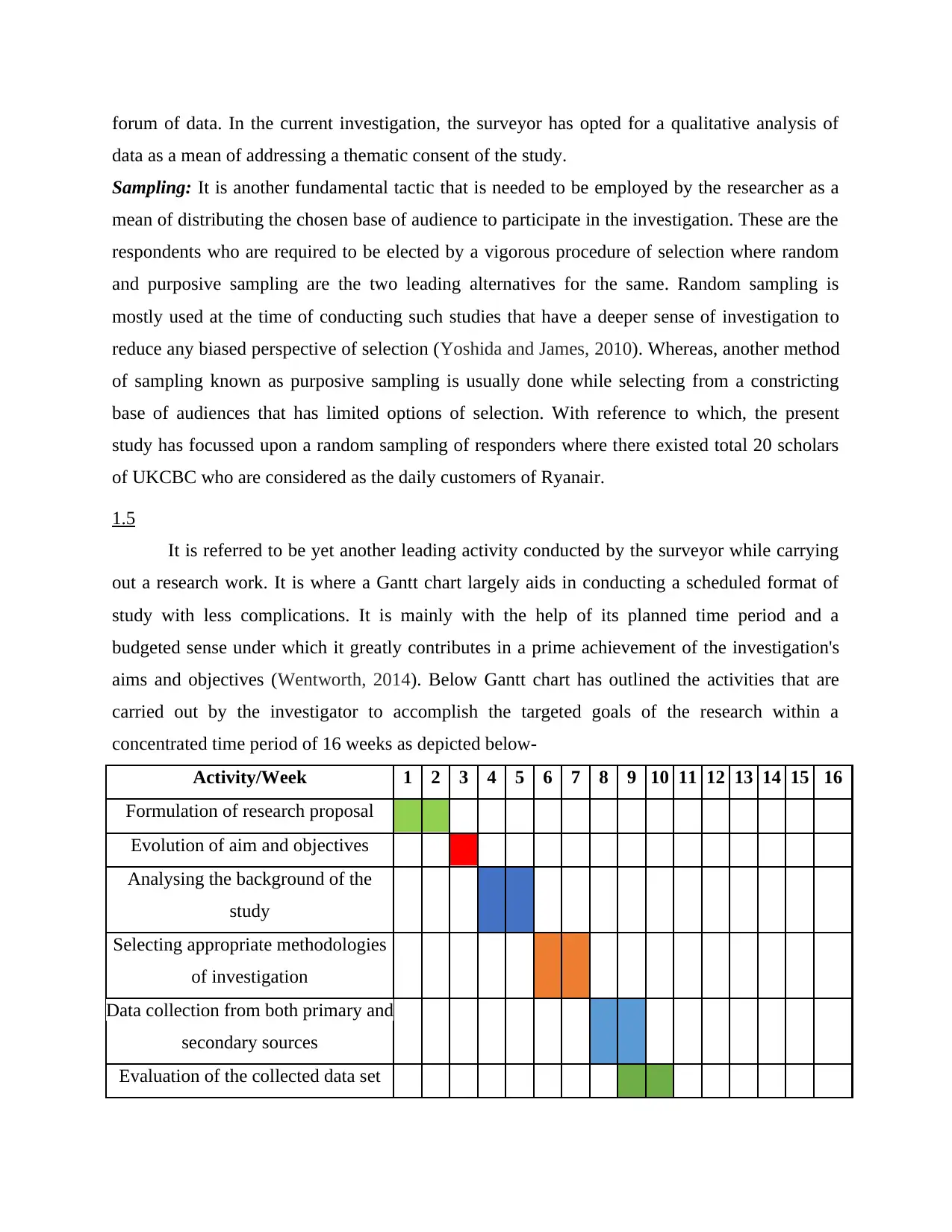
forum of data. In the current investigation, the surveyor has opted for a qualitative analysis of
data as a mean of addressing a thematic consent of the study.
Sampling: It is another fundamental tactic that is needed to be employed by the researcher as a
mean of distributing the chosen base of audience to participate in the investigation. These are the
respondents who are required to be elected by a vigorous procedure of selection where random
and purposive sampling are the two leading alternatives for the same. Random sampling is
mostly used at the time of conducting such studies that have a deeper sense of investigation to
reduce any biased perspective of selection (Yoshida and James, 2010). Whereas, another method
of sampling known as purposive sampling is usually done while selecting from a constricting
base of audiences that has limited options of selection. With reference to which, the present
study has focussed upon a random sampling of responders where there existed total 20 scholars
of UKCBC who are considered as the daily customers of Ryanair.
1.5
It is referred to be yet another leading activity conducted by the surveyor while carrying
out a research work. It is where a Gantt chart largely aids in conducting a scheduled format of
study with less complications. It is mainly with the help of its planned time period and a
budgeted sense under which it greatly contributes in a prime achievement of the investigation's
aims and objectives (Wentworth, 2014). Below Gantt chart has outlined the activities that are
carried out by the investigator to accomplish the targeted goals of the research within a
concentrated time period of 16 weeks as depicted below-
Activity/Week 1 2 3 4 5 6 7 8 9 10 11 12 13 14 15 16
Formulation of research proposal
Evolution of aim and objectives
Analysing the background of the
study
Selecting appropriate methodologies
of investigation
Data collection from both primary and
secondary sources
Evaluation of the collected data set
data as a mean of addressing a thematic consent of the study.
Sampling: It is another fundamental tactic that is needed to be employed by the researcher as a
mean of distributing the chosen base of audience to participate in the investigation. These are the
respondents who are required to be elected by a vigorous procedure of selection where random
and purposive sampling are the two leading alternatives for the same. Random sampling is
mostly used at the time of conducting such studies that have a deeper sense of investigation to
reduce any biased perspective of selection (Yoshida and James, 2010). Whereas, another method
of sampling known as purposive sampling is usually done while selecting from a constricting
base of audiences that has limited options of selection. With reference to which, the present
study has focussed upon a random sampling of responders where there existed total 20 scholars
of UKCBC who are considered as the daily customers of Ryanair.
1.5
It is referred to be yet another leading activity conducted by the surveyor while carrying
out a research work. It is where a Gantt chart largely aids in conducting a scheduled format of
study with less complications. It is mainly with the help of its planned time period and a
budgeted sense under which it greatly contributes in a prime achievement of the investigation's
aims and objectives (Wentworth, 2014). Below Gantt chart has outlined the activities that are
carried out by the investigator to accomplish the targeted goals of the research within a
concentrated time period of 16 weeks as depicted below-
Activity/Week 1 2 3 4 5 6 7 8 9 10 11 12 13 14 15 16
Formulation of research proposal
Evolution of aim and objectives
Analysing the background of the
study
Selecting appropriate methodologies
of investigation
Data collection from both primary and
secondary sources
Evaluation of the collected data set
Paraphrase This Document
Need a fresh take? Get an instant paraphrase of this document with our AI Paraphraser
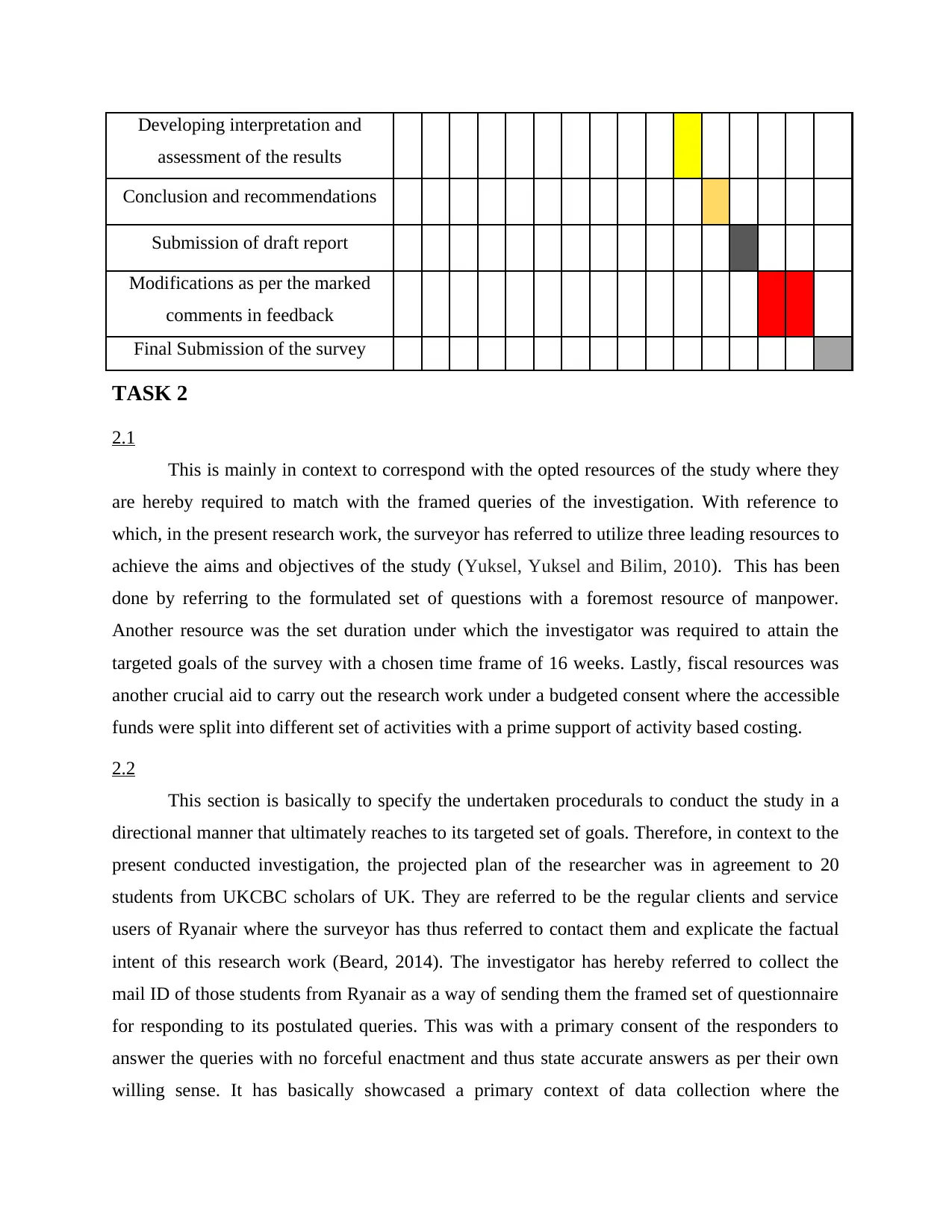
Developing interpretation and
assessment of the results
Conclusion and recommendations
Submission of draft report
Modifications as per the marked
comments in feedback
Final Submission of the survey
TASK 2
2.1
This is mainly in context to correspond with the opted resources of the study where they
are hereby required to match with the framed queries of the investigation. With reference to
which, in the present research work, the surveyor has referred to utilize three leading resources to
achieve the aims and objectives of the study (Yuksel, Yuksel and Bilim, 2010). This has been
done by referring to the formulated set of questions with a foremost resource of manpower.
Another resource was the set duration under which the investigator was required to attain the
targeted goals of the survey with a chosen time frame of 16 weeks. Lastly, fiscal resources was
another crucial aid to carry out the research work under a budgeted consent where the accessible
funds were split into different set of activities with a prime support of activity based costing.
2.2
This section is basically to specify the undertaken procedurals to conduct the study in a
directional manner that ultimately reaches to its targeted set of goals. Therefore, in context to the
present conducted investigation, the projected plan of the researcher was in agreement to 20
students from UKCBC scholars of UK. They are referred to be the regular clients and service
users of Ryanair where the surveyor has thus referred to contact them and explicate the factual
intent of this research work (Beard, 2014). The investigator has hereby referred to collect the
mail ID of those students from Ryanair as a way of sending them the framed set of questionnaire
for responding to its postulated queries. This was with a primary consent of the responders to
answer the queries with no forceful enactment and thus state accurate answers as per their own
willing sense. It has basically showcased a primary context of data collection where the
assessment of the results
Conclusion and recommendations
Submission of draft report
Modifications as per the marked
comments in feedback
Final Submission of the survey
TASK 2
2.1
This is mainly in context to correspond with the opted resources of the study where they
are hereby required to match with the framed queries of the investigation. With reference to
which, in the present research work, the surveyor has referred to utilize three leading resources to
achieve the aims and objectives of the study (Yuksel, Yuksel and Bilim, 2010). This has been
done by referring to the formulated set of questions with a foremost resource of manpower.
Another resource was the set duration under which the investigator was required to attain the
targeted goals of the survey with a chosen time frame of 16 weeks. Lastly, fiscal resources was
another crucial aid to carry out the research work under a budgeted consent where the accessible
funds were split into different set of activities with a prime support of activity based costing.
2.2
This section is basically to specify the undertaken procedurals to conduct the study in a
directional manner that ultimately reaches to its targeted set of goals. Therefore, in context to the
present conducted investigation, the projected plan of the researcher was in agreement to 20
students from UKCBC scholars of UK. They are referred to be the regular clients and service
users of Ryanair where the surveyor has thus referred to contact them and explicate the factual
intent of this research work (Beard, 2014). The investigator has hereby referred to collect the
mail ID of those students from Ryanair as a way of sending them the framed set of questionnaire
for responding to its postulated queries. This was with a primary consent of the responders to
answer the queries with no forceful enactment and thus state accurate answers as per their own
willing sense. It has basically showcased a primary context of data collection where the
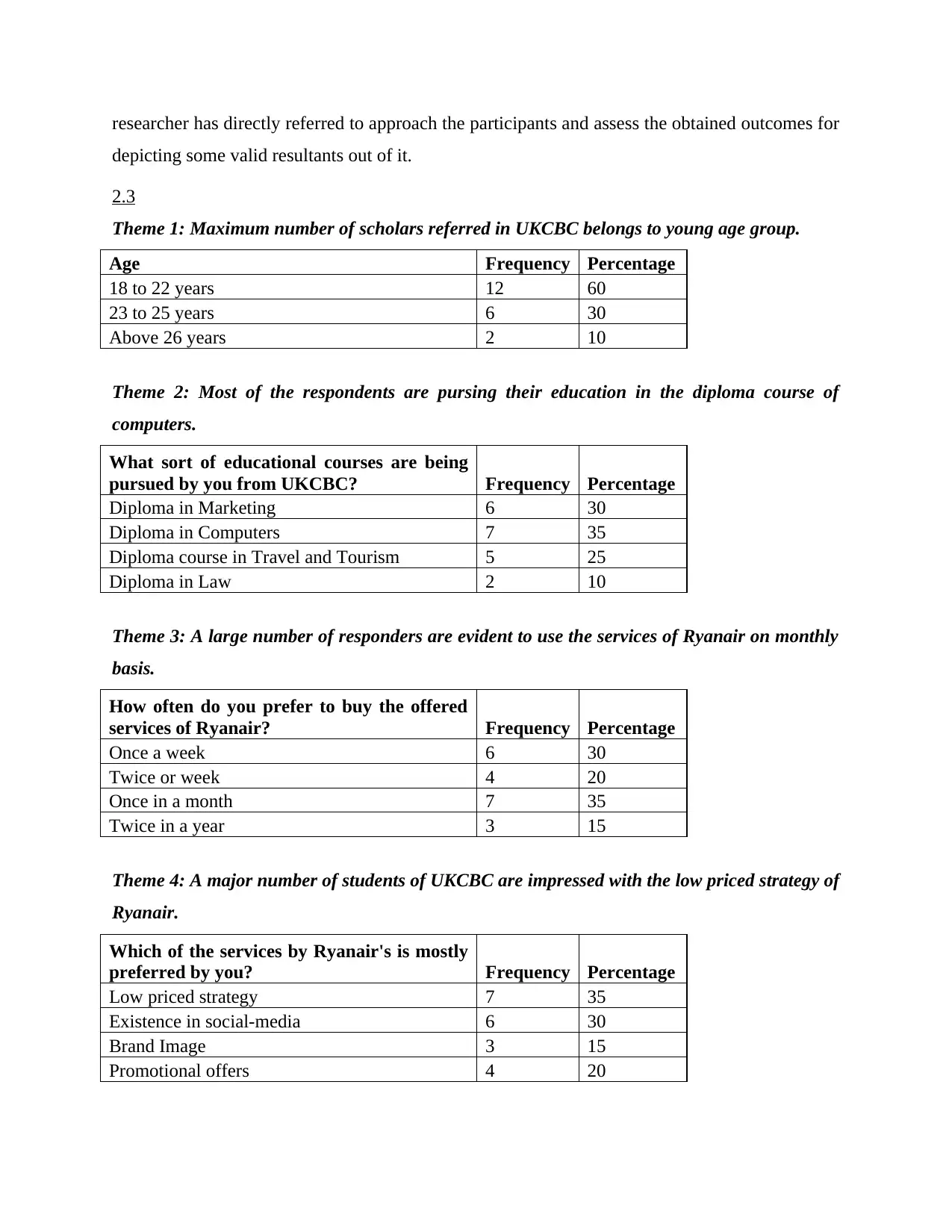
researcher has directly referred to approach the participants and assess the obtained outcomes for
depicting some valid resultants out of it.
2.3
Theme 1: Maximum number of scholars referred in UKCBC belongs to young age group.
Age Frequency Percentage
18 to 22 years 12 60
23 to 25 years 6 30
Above 26 years 2 10
Theme 2: Most of the respondents are pursing their education in the diploma course of
computers.
What sort of educational courses are being
pursued by you from UKCBC? Frequency Percentage
Diploma in Marketing 6 30
Diploma in Computers 7 35
Diploma course in Travel and Tourism 5 25
Diploma in Law 2 10
Theme 3: A large number of responders are evident to use the services of Ryanair on monthly
basis.
How often do you prefer to buy the offered
services of Ryanair? Frequency Percentage
Once a week 6 30
Twice or week 4 20
Once in a month 7 35
Twice in a year 3 15
Theme 4: A major number of students of UKCBC are impressed with the low priced strategy of
Ryanair.
Which of the services by Ryanair's is mostly
preferred by you? Frequency Percentage
Low priced strategy 7 35
Existence in social-media 6 30
Brand Image 3 15
Promotional offers 4 20
depicting some valid resultants out of it.
2.3
Theme 1: Maximum number of scholars referred in UKCBC belongs to young age group.
Age Frequency Percentage
18 to 22 years 12 60
23 to 25 years 6 30
Above 26 years 2 10
Theme 2: Most of the respondents are pursing their education in the diploma course of
computers.
What sort of educational courses are being
pursued by you from UKCBC? Frequency Percentage
Diploma in Marketing 6 30
Diploma in Computers 7 35
Diploma course in Travel and Tourism 5 25
Diploma in Law 2 10
Theme 3: A large number of responders are evident to use the services of Ryanair on monthly
basis.
How often do you prefer to buy the offered
services of Ryanair? Frequency Percentage
Once a week 6 30
Twice or week 4 20
Once in a month 7 35
Twice in a year 3 15
Theme 4: A major number of students of UKCBC are impressed with the low priced strategy of
Ryanair.
Which of the services by Ryanair's is mostly
preferred by you? Frequency Percentage
Low priced strategy 7 35
Existence in social-media 6 30
Brand Image 3 15
Promotional offers 4 20
⊘ This is a preview!⊘
Do you want full access?
Subscribe today to unlock all pages.

Trusted by 1+ million students worldwide
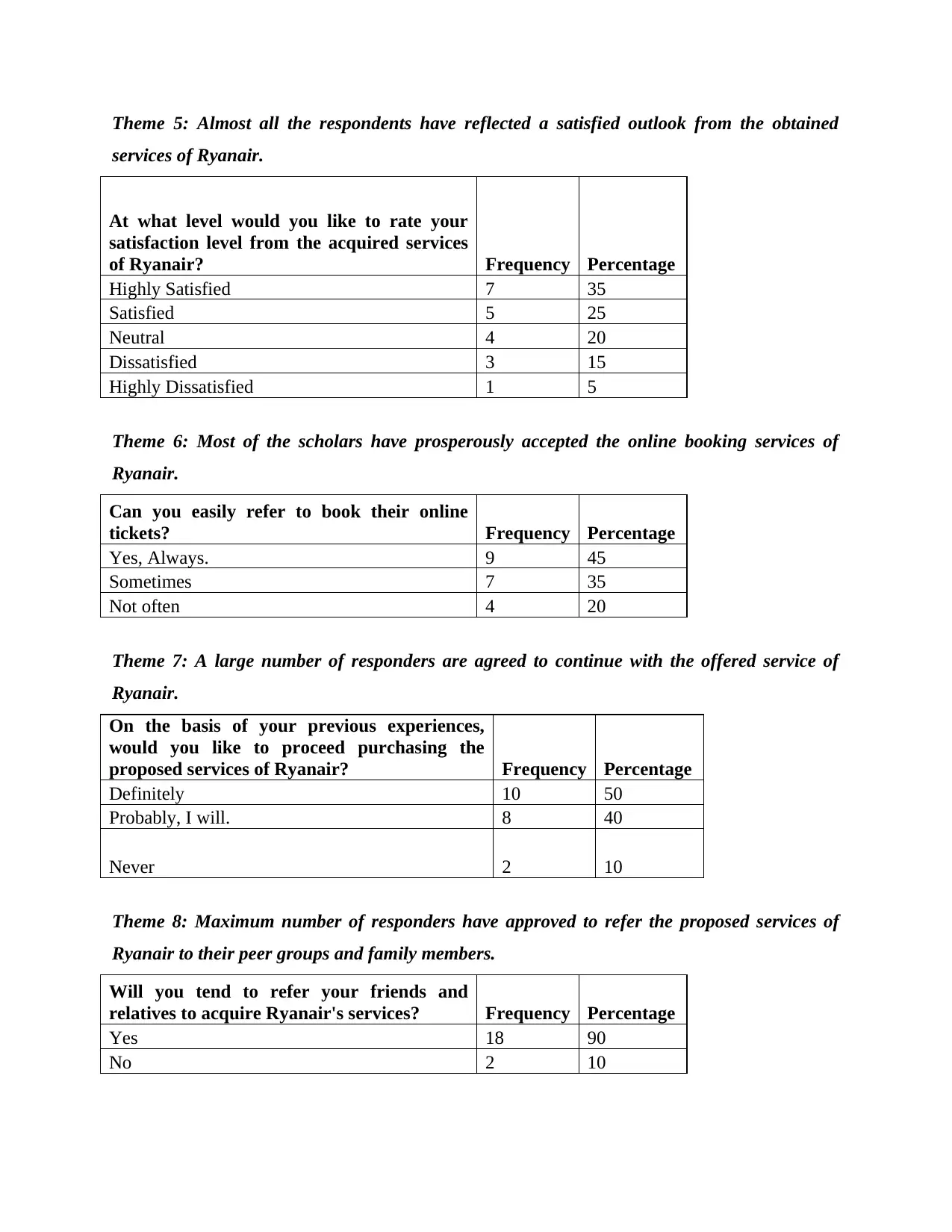
Theme 5: Almost all the respondents have reflected a satisfied outlook from the obtained
services of Ryanair.
At what level would you like to rate your
satisfaction level from the acquired services
of Ryanair? Frequency Percentage
Highly Satisfied 7 35
Satisfied 5 25
Neutral 4 20
Dissatisfied 3 15
Highly Dissatisfied 1 5
Theme 6: Most of the scholars have prosperously accepted the online booking services of
Ryanair.
Can you easily refer to book their online
tickets? Frequency Percentage
Yes, Always. 9 45
Sometimes 7 35
Not often 4 20
Theme 7: A large number of responders are agreed to continue with the offered service of
Ryanair.
On the basis of your previous experiences,
would you like to proceed purchasing the
proposed services of Ryanair? Frequency Percentage
Definitely 10 50
Probably, I will. 8 40
Never 2 10
Theme 8: Maximum number of responders have approved to refer the proposed services of
Ryanair to their peer groups and family members.
Will you tend to refer your friends and
relatives to acquire Ryanair's services? Frequency Percentage
Yes 18 90
No 2 10
services of Ryanair.
At what level would you like to rate your
satisfaction level from the acquired services
of Ryanair? Frequency Percentage
Highly Satisfied 7 35
Satisfied 5 25
Neutral 4 20
Dissatisfied 3 15
Highly Dissatisfied 1 5
Theme 6: Most of the scholars have prosperously accepted the online booking services of
Ryanair.
Can you easily refer to book their online
tickets? Frequency Percentage
Yes, Always. 9 45
Sometimes 7 35
Not often 4 20
Theme 7: A large number of responders are agreed to continue with the offered service of
Ryanair.
On the basis of your previous experiences,
would you like to proceed purchasing the
proposed services of Ryanair? Frequency Percentage
Definitely 10 50
Probably, I will. 8 40
Never 2 10
Theme 8: Maximum number of responders have approved to refer the proposed services of
Ryanair to their peer groups and family members.
Will you tend to refer your friends and
relatives to acquire Ryanair's services? Frequency Percentage
Yes 18 90
No 2 10
Paraphrase This Document
Need a fresh take? Get an instant paraphrase of this document with our AI Paraphraser
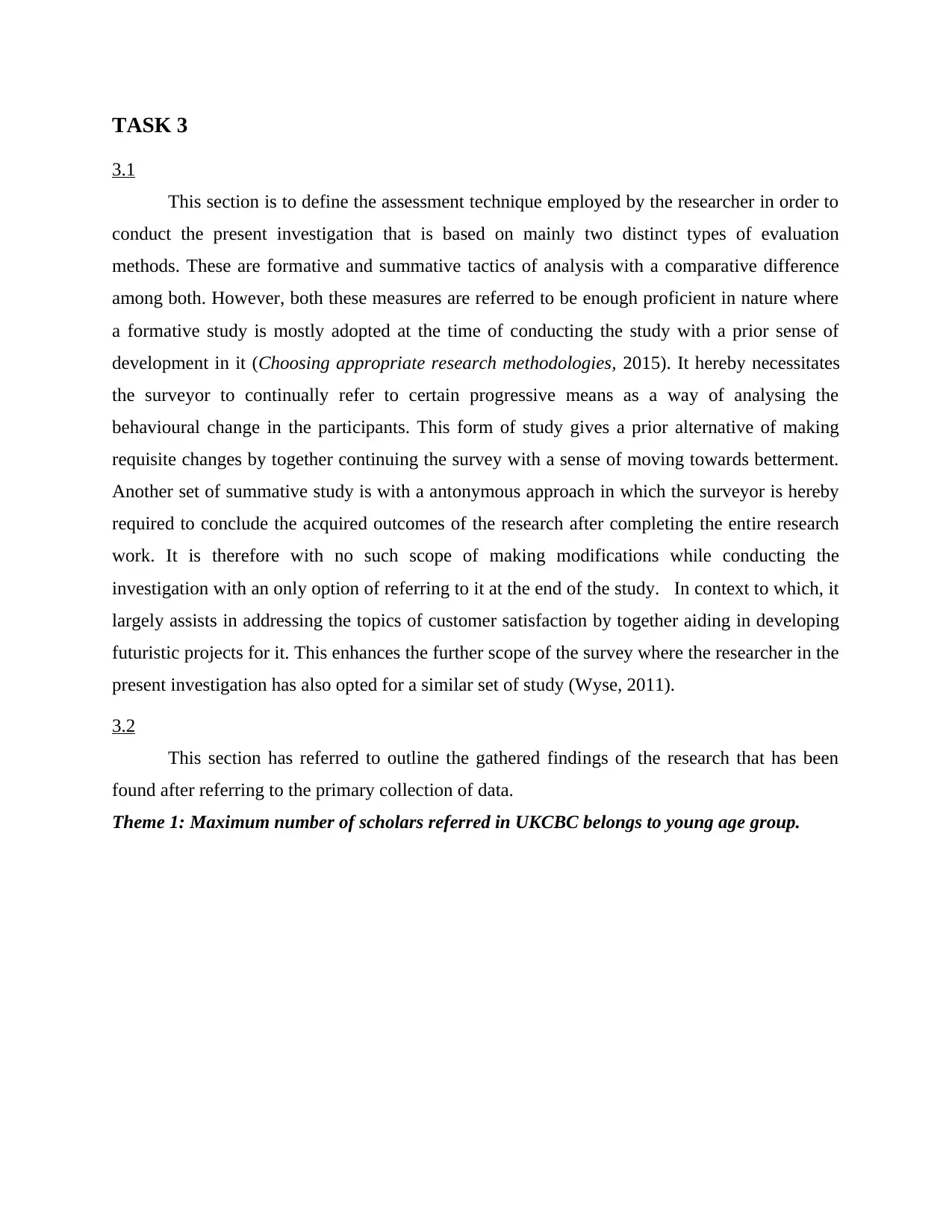
TASK 3
3.1
This section is to define the assessment technique employed by the researcher in order to
conduct the present investigation that is based on mainly two distinct types of evaluation
methods. These are formative and summative tactics of analysis with a comparative difference
among both. However, both these measures are referred to be enough proficient in nature where
a formative study is mostly adopted at the time of conducting the study with a prior sense of
development in it (Choosing appropriate research methodologies, 2015). It hereby necessitates
the surveyor to continually refer to certain progressive means as a way of analysing the
behavioural change in the participants. This form of study gives a prior alternative of making
requisite changes by together continuing the survey with a sense of moving towards betterment.
Another set of summative study is with a antonymous approach in which the surveyor is hereby
required to conclude the acquired outcomes of the research after completing the entire research
work. It is therefore with no such scope of making modifications while conducting the
investigation with an only option of referring to it at the end of the study. In context to which, it
largely assists in addressing the topics of customer satisfaction by together aiding in developing
futuristic projects for it. This enhances the further scope of the survey where the researcher in the
present investigation has also opted for a similar set of study (Wyse, 2011).
3.2
This section has referred to outline the gathered findings of the research that has been
found after referring to the primary collection of data.
Theme 1: Maximum number of scholars referred in UKCBC belongs to young age group.
3.1
This section is to define the assessment technique employed by the researcher in order to
conduct the present investigation that is based on mainly two distinct types of evaluation
methods. These are formative and summative tactics of analysis with a comparative difference
among both. However, both these measures are referred to be enough proficient in nature where
a formative study is mostly adopted at the time of conducting the study with a prior sense of
development in it (Choosing appropriate research methodologies, 2015). It hereby necessitates
the surveyor to continually refer to certain progressive means as a way of analysing the
behavioural change in the participants. This form of study gives a prior alternative of making
requisite changes by together continuing the survey with a sense of moving towards betterment.
Another set of summative study is with a antonymous approach in which the surveyor is hereby
required to conclude the acquired outcomes of the research after completing the entire research
work. It is therefore with no such scope of making modifications while conducting the
investigation with an only option of referring to it at the end of the study. In context to which, it
largely assists in addressing the topics of customer satisfaction by together aiding in developing
futuristic projects for it. This enhances the further scope of the survey where the researcher in the
present investigation has also opted for a similar set of study (Wyse, 2011).
3.2
This section has referred to outline the gathered findings of the research that has been
found after referring to the primary collection of data.
Theme 1: Maximum number of scholars referred in UKCBC belongs to young age group.
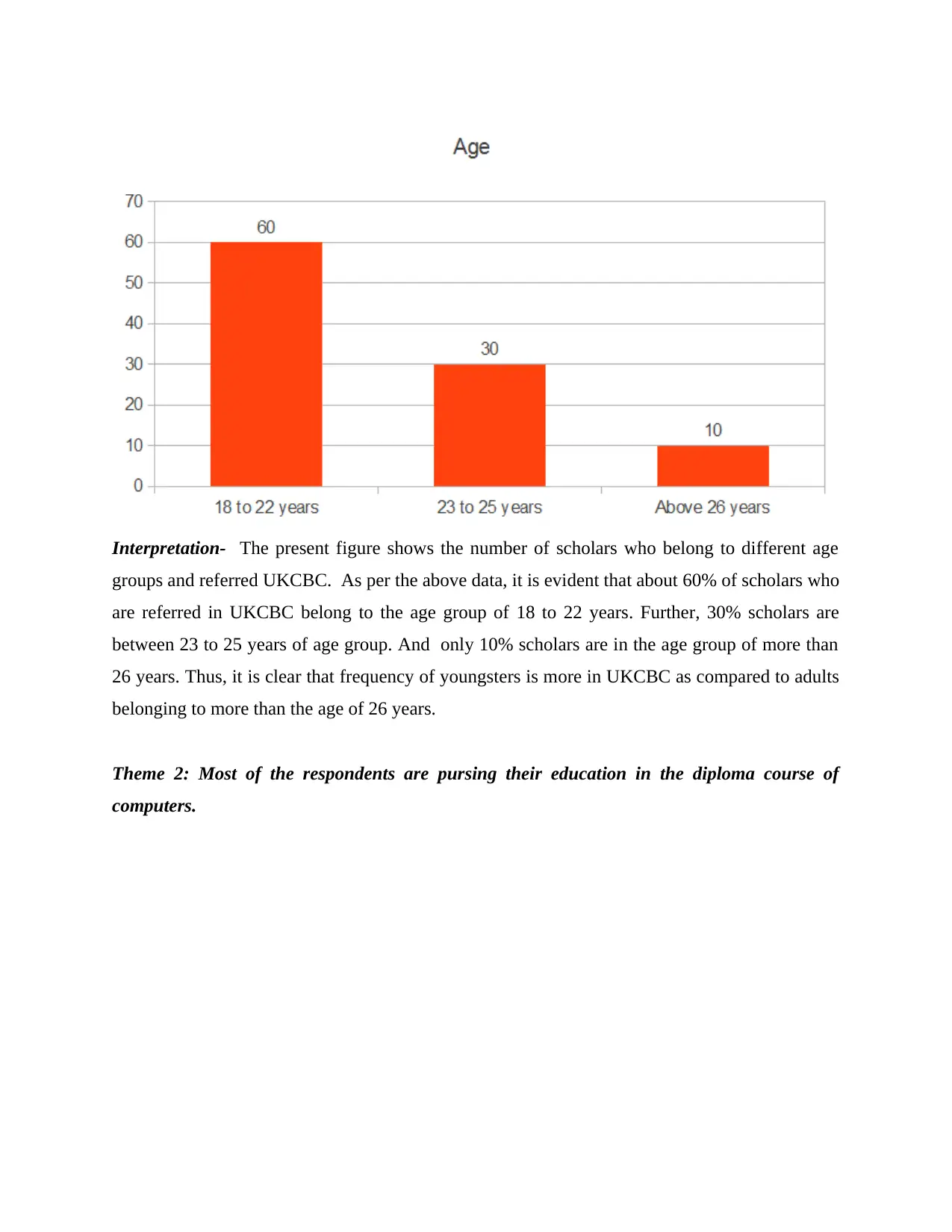
Interpretation- The present figure shows the number of scholars who belong to different age
groups and referred UKCBC. As per the above data, it is evident that about 60% of scholars who
are referred in UKCBC belong to the age group of 18 to 22 years. Further, 30% scholars are
between 23 to 25 years of age group. And only 10% scholars are in the age group of more than
26 years. Thus, it is clear that frequency of youngsters is more in UKCBC as compared to adults
belonging to more than the age of 26 years.
Theme 2: Most of the respondents are pursing their education in the diploma course of
computers.
groups and referred UKCBC. As per the above data, it is evident that about 60% of scholars who
are referred in UKCBC belong to the age group of 18 to 22 years. Further, 30% scholars are
between 23 to 25 years of age group. And only 10% scholars are in the age group of more than
26 years. Thus, it is clear that frequency of youngsters is more in UKCBC as compared to adults
belonging to more than the age of 26 years.
Theme 2: Most of the respondents are pursing their education in the diploma course of
computers.
⊘ This is a preview!⊘
Do you want full access?
Subscribe today to unlock all pages.

Trusted by 1+ million students worldwide
1 out of 29
Related Documents
Your All-in-One AI-Powered Toolkit for Academic Success.
+13062052269
info@desklib.com
Available 24*7 on WhatsApp / Email
![[object Object]](/_next/static/media/star-bottom.7253800d.svg)
Unlock your academic potential
Copyright © 2020–2025 A2Z Services. All Rights Reserved. Developed and managed by ZUCOL.





